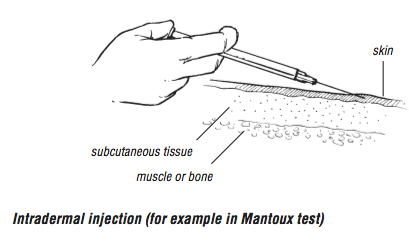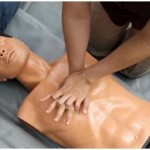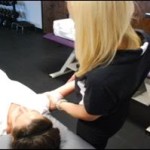An intradermal injection is an injection that contains a small amount of fluid into the dermal layer of the skin. The most common use of the intradermal injection is for diagnostic measure, such as for tuberculin testing and allergy testing. The intradermal injection can be applied in the skin areas of the body that are soft and yielding. If you want to apply an intradermal injection for tuberculin testing you have to know that the tuberculin syringe is the only syringe with enough calibrations to measure the minute dose that is used. The needle that is selected for this procedure is 26-gauge, which means that is one-fourth to one-half inch in length. When you start to apply the fluid you will notice a small swelling of the skin due to the medication placed under the skin, the location of the fluid is just under the surface of the skin and between its layers.
What Is An Intradermal Injection – Video
Videos on
this site are for entertainment purposes only. Please
do not attempt any of the procedures seen in these videos
without formal medical education & licensing.
What Is An Intradermal Injection Procedure?
 Clean the area: This is the most important part of the procedure. Before we start to administer the intradermal injection we have to clean the injection site by using alcohol and wait a couple of seconds to see if the area is dry enough.
Clean the area: This is the most important part of the procedure. Before we start to administer the intradermal injection we have to clean the injection site by using alcohol and wait a couple of seconds to see if the area is dry enough.
Select the site: After you clean the area you can select the injection site and prepare our patient for the procedure that you are going to perform. The most common sites for intradermal injection are the palmer (inner) forearm or the subscapular region on the back side. The site that you have selected should be an easily obtainable area and relatively free from being rubbed by clothing.
The position of the patient: The position of the patients is very important in order for you to perform this procedure. First you have place the patient’s arm in a relaxed position, with his elbow flexed. The patient should be with his palm up so he can expose his palmer or inner arm area.
Prepare the injection site: You have placed your patient in his position, now you have to prepare the injection site. The preparation of the injection site starts with cleaning the area with alcohol. After the area is set up, you have to remove gently the needle guard by pulling the guard straight off.
Stabilize the injection site: This can be done by using your no dominant thumb. You have to apply a downward pressure below and outside the prepared injection site. Most of the technicians draw the skin back. Do not do that! The skin will return to its normal position when the pressure is released and this will cause the needle bevel to either go deeper into the skin or leave the skin. You will have to go deeper upon in which direction the skin moves. To stabilize the injection site you have to hold the skin taut until the needle bevel has been inserted between the skin layers.
Needle insertion: Insert the needle with your dominant hand, hold the syringe with the other hand, bevel up, and put your fingers and your thumb on the sides of the barrel. If you have a situation like inserting the needle at a 20 degree angle, just lower it at once to 15 degrees. You shouldn’t place your thumbs or fingers under the syringe; this will cause the angle of insertion to exceed 15 degrees, the needle will be inserted beyond the dermis. Insert the needle, bevel up, and continue stabilizing using your thumb pressure. If you feel that the needle tip moves freely than you have inserted the needle too deeply.
Medication injecting process: When you are injecting medication there is no need for aspiration. There are no large vessels. Continue holding the syringe with the same hand and release the skin tension with your other hand. Push the plunger slowly forward until the medication is injected and a wheal will appear at the site of the injection. This weal indicates that the medication has entered in the area between the intradermal tissues.
Evaluation: Always evaluate if there is any reaction of the given medication. The specialist will not evaluate the reaction of a suspected allergic reaction or a tuberculin test, but if there are any reactions he will record it. Tell your patient to wait or return to have the test read according to local SOP. No rubbing, scratching, or washing. This may spread or dilute the medication and cause false reading. Warn your patient about this and tell them to wait or come back so you can evaluate reaction of medication.






















